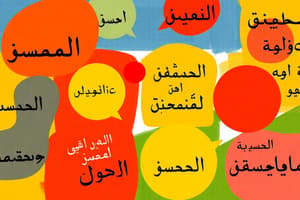Podcast
Questions and Answers
Which of the following is a characteristic that distinguishes between Bedouin and Sedentary Arabic?
Which of the following is a characteristic that distinguishes between Bedouin and Sedentary Arabic?
- Word order
- Morphology (correct)
- Phonetics
- Syntax
What is code-switching in Arabic?
What is code-switching in Arabic?
- The use of multiple varieties of Arabic in a conversation or sentence (correct)
- The use of formal Arabic in a conversation or sentence
- The use of Arabic and another language in a conversation or sentence
- The use of colloquial Arabic in a conversation or sentence
What is the most obvious phonetic difference between urban and post-Arabized Arabic?
What is the most obvious phonetic difference between urban and post-Arabized Arabic?
- Pronunciation of the letter ع ain
- Pronunciation of the letter ق qaf (correct)
- Pronunciation of the letter ض dad
- Pronunciation of the letter ظ zha
What is a prestige dialect in Arabic?
What is a prestige dialect in Arabic?
What is the classification of modern Arabic varieties?
What is the classification of modern Arabic varieties?
What is the major difference between classical/standard Arabic and colloquial Arabic?
What is the major difference between classical/standard Arabic and colloquial Arabic?
What is Maltese?
What is Maltese?
What are the factors that can lead to the mixing or changing of Arabic?
What are the factors that can lead to the mixing or changing of Arabic?
What languages have influenced Jewish and creole varieties of Arabic?
What languages have influenced Jewish and creole varieties of Arabic?
Study Notes
Varieties of Arabic, a Semitic language in the Afroasiatic family, have considerable variations from region to region, with degrees of mutual intelligibility that are often related to geographical distance and some that are mutually unintelligible.
The largest differences between the classical/standard and the colloquial Arabic are the loss of grammatical case; a different and strict word order; the loss of the previous system of grammatical mood, along with the evolution of a new system; the loss of the inflected passive voice, except in a few relic varieties; restriction in the use of the dual number and (for most varieties) the loss of the distinctive conjugation and agreement for feminine plurals.
In terms of typological classification, Arabic dialectologists distinguish between two basic norms: Bedouin and Sedentary. This is based on a set of phonological, morphological, and syntactic characteristics that distinguish between these two norms.
Modern Arabic varieties are classified into six groups: Maghrebi, Sudanese, Egyptian, Mesopotamian, Levantine and Peninsular Arabic. Speakers from distant areas, across national borders, within countries and even between cities and villages, can struggle to understand each other's dialects.
Arabic speakers often use more than one variety of Arabic within a conversation or even a sentence. This process is referred to as code-switching.
An important factor in the mixing or changing of Arabic is the concept of a prestige dialect. This refers to the level of respect accorded to a language or dialect within a speech community.
The formal Arabic language carries a considerable prestige in most Arabic-speaking communities, depending on the context. This is not the only source of prestige, though.
The most obvious phonetic difference between the two groups of Arabic is the pronunciation of the letter ق qaf, which is pronounced as a voiced /ɡ/ in the urban varieties of the Arabian Peninsula and in the Bedouin dialects across all Arabic-speaking countries, but is voiceless mainly in post-Arabized urban centers as either /q/ or /ʔ/.
A number of cities in the Arabic world speak a "Bedouin" variety, which acquires prestige in that context.
Maltese, a highly divergent Siculo-Arabic language descended from Maghrebi Arabic, is also provided as an example of major regional differences.
Jewish and creole varieties of Arabic are also influenced by other languages such as Hebrew, Aramaic, and Romance languages.Varieties of Arabic: Peripheral, Pidgins, Formal and Vernacular Differences, Linguistic Distance to MSA, Sociolinguistic Variables, Variation in Writing System, Morphology and Syntax, Phonetics, and Consonants.
Studying That Suits You
Use AI to generate personalized quizzes and flashcards to suit your learning preferences.
Description
How much do you know about the varieties of Arabic? Take this quiz to test your knowledge on the peripheral, pidgins, formal and vernacular differences, linguistic distance to MSA, sociolinguistic variables, variation in writing system, morphology and syntax, phonetics, and consonants. Learn about the different norms, classifications, and factors that influence the mixing and changing of Arabic dialects. Challenge yourself and see how much you know about this diverse and complex language family.




